QuinStreet Bundle
Who Really Controls QuinStreet?
Understanding the QuinStreet SWOT Analysis is crucial, but have you ever wondered who truly steers the ship of this performance marketing giant? From its IPO in 2010 to its current market position, QuinStreet's ownership structure has evolved significantly. Knowing who owns QuinStreet is key to grasping its strategic moves and future trajectory.
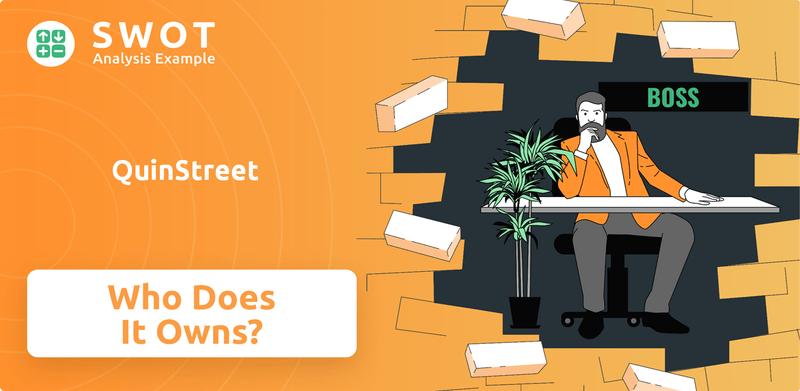
This exploration into QuinStreet's ownership will reveal the influence of its founders, key institutional investors, and the impact of public shareholders. We'll examine the shifts in QuinStreet's ownership landscape, providing insights into the company's governance and the interests of its major shareholders. Furthermore, we'll analyze the roles of QuinStreet executives and the implications for QuinStreet stock performance, offering a comprehensive view of this dynamic company.
Who Founded QuinStreet?
The story of QuinStreet's beginnings centers on its founders and early investors. Understanding the initial ownership structure provides crucial context for analyzing the company's subsequent growth and evolution. Key figures and early backers significantly shaped the company's trajectory.
Doug Valenti, the founder, has been a central figure in the company since its inception in 1999. He has served as Chief Executive Officer and Chairman. Bronwyn Syiek was another pivotal member of the founding team, serving as president and COO. The initial funding came from personal savings and investments from friends and family.
Early venture capital played a significant role in the company's development. Split Rock Partners was a major early investor. James Simons, a founding managing director at Split Rock, has been on the board of directors since the beginning. This early backing helped shape QuinStreet's foundational ownership and strategic direction.
Doug Valenti founded the company in 1999 and has been the CEO since July 1999. He also became Chairman in March 2004. Bronwyn Syiek was another key founder, serving as president and COO.
The initial funding for QuinStreet came from the founders' personal savings, along with investments from friends and family.
Split Rock Partners was an early investor. James Simons, a founding managing director, has been on the board since 1999.
At the time of the IPO in 2010, Split Rock Partners was a major shareholder, second only to Doug Valenti.
Specific equity splits and details like vesting schedules from the early days are not readily available in public records.
The early involvement of key investors like Split Rock Partners helped shape the company's foundational ownership and strategic direction.
The early ownership of the QuinStreet company was primarily controlled by the founders, with significant backing from venture capital firms like Split Rock Partners. The early involvement of these QuinStreet investors and the leadership of QuinStreet executives like Doug Valenti were crucial in setting the stage for the company's future. While specific details of early equity splits are not available, the influence of these early backers is undeniable. Understanding the QuinStreet ownership structure from the beginning provides a foundation for analyzing the company's growth. Information on QuinStreet's major shareholders and QuinStreet's current CEO can be found in public filings. As of the latest available data, the company's financial performance and QuinStreet stock are subject to market fluctuations.
The early ownership of QuinStreet was shaped by its founders and early investors.
- Doug Valenti, the founder, has been CEO since 1999 and Chairman since 2004.
- Bronwyn Syiek was a key founding team member.
- Split Rock Partners was a significant early investor.
- Early agreements like vesting schedules are not readily available.
QuinStreet SWOT Analysis
- Complete SWOT Breakdown
- Fully Customizable
- Editable in Excel & Word
- Professional Formatting
- Investor-Ready Format
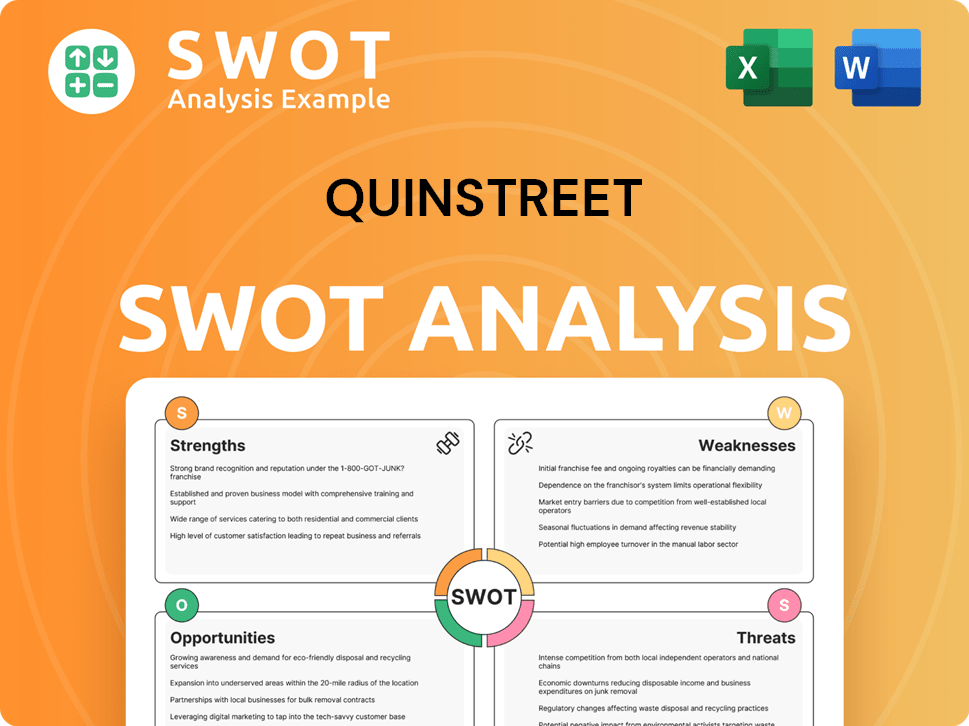
How Has QuinStreet’s Ownership Changed Over Time?
The ownership structure of the [Company Name] underwent a significant transformation with its initial public offering (IPO) on February 11, 2010. This IPO, which raised $150 million, marked a pivotal moment, shifting the company's ownership from private to public, and listed its shares on Nasdaq under the ticker symbol QNST. The transition brought in a mix of institutional, retail, and individual investors, changing the dynamics of the company's governance and strategic direction.
Since the IPO, the ownership has seen further evolution. As of May 2025, the majority of the shares are held by institutional investors, reflecting a shift towards large-scale investment firms. The company's major shareholders and their holdings have become key factors in influencing the company's strategic decisions and overall governance. This shift highlights the increasing appeal of the company to significant investors.
| Shareholder | Shares Held | Percentage of Ownership (May 2025) |
|---|---|---|
| Blackrock Inc. | 10,250,913 | 18.00% |
| Vanguard Group Inc. | 4,027,512 | 7.07% |
| Glenn Solomon | 5,433,950 | 9.54% |
| Douglas Valenti | 3,899,616 | 6.85% |
| James R. Simons | 3,511,828 | 6.17% |
As of May 2025, institutional investors hold approximately 92.76% of the company's stock, while insiders hold 3.73%. Mutual funds held 68.99% of the shares in May 2025. The increase in institutional ownership, with institutions increasing their holdings by 0.5334% in May 2025, indicates growing confidence from large investment firms. This ownership structure plays a crucial role in shaping the company's future. For further insights into the company's strategic direction, consider exploring the Growth Strategy of QuinStreet.
The ownership of the company has evolved significantly since its IPO in 2010, with a shift towards institutional investors.
- Institutional investors hold the majority of shares, indicating confidence from large investment firms.
- Key individual insiders and major institutional shareholders significantly influence company decisions.
- Understanding the ownership structure is vital for investors and stakeholders.
- The company's stock is listed on Nasdaq under the ticker symbol QNST.
QuinStreet PESTLE Analysis
- Covers All 6 PESTLE Categories
- No Research Needed – Save Hours of Work
- Built by Experts, Trusted by Consultants
- Instant Download, Ready to Use
- 100% Editable, Fully Customizable
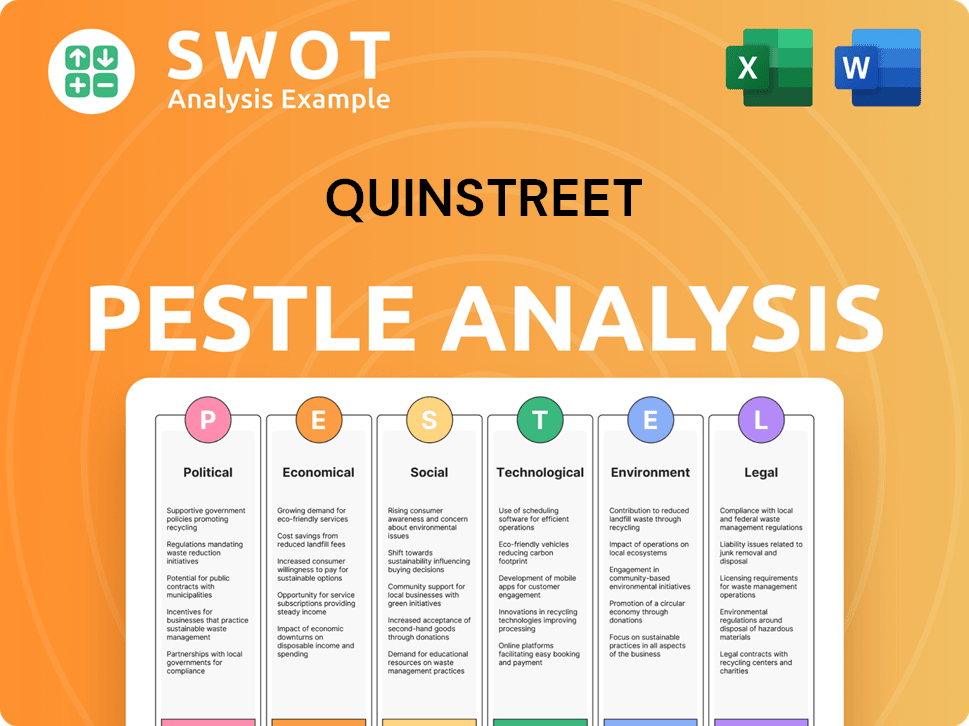
Who Sits on QuinStreet’s Board?
The current board of directors of the QuinStreet company is pivotal in guiding the company's operations. Doug Valenti, the founder, holds the dual roles of CEO and Chairman, thus maintaining a central position in both leadership and strategic planning. In the 2024 Annual Meeting of Stockholders, Andrew Sheehan and Douglas Valenti were re-elected as Class III directors, with their terms expiring at the 2027 annual meeting. Sheehan received 42,305,279 votes in favor, and Valenti received 46,443,434 votes in favor, demonstrating substantial backing from shareholders.
The composition of the board reflects the interests of major shareholders, which is a critical aspect of QuinStreet ownership. The strong shareholder support for the re-election of directors highlights the confidence in the current leadership and the direction of the company. This structure ensures that the company's governance remains aligned with the long-term interests of its investors and stakeholders.
| Director | Title | Votes For (2024) |
|---|---|---|
| Doug Valenti | CEO and Chairman | 46,443,434 |
| Andrew Sheehan | Director | 42,305,279 |
| Other Directors | Various | Data Not Publicly Available |
QuinStreet's voting structure generally adheres to a one-share, one-vote principle for its common stock. Shareholders do not have the right to cumulate votes for the election of directors. The high participation rate at the 2024 annual meeting, with 95.08% of outstanding shares present or represented by proxy, showcases the active engagement of QuinStreet's shareholders in governance matters. While there are no publicly noted dual-class shares or golden shares that grant outsized control, the significant holdings of insiders and large institutional investors provide them with substantial voting power. Recent proxy battles or activist investor campaigns have not been prominently reported, suggesting a relatively stable governance environment. This stability is crucial for QuinStreet's financial performance and its ability to execute its business model effectively.
Understanding the board of directors and voting power is crucial for QuinStreet investors. The founder, Doug Valenti, plays a central role in the company's leadership. High shareholder participation in the 2024 annual meeting indicates strong investor engagement.
- The board includes key figures like Doug Valenti and Andrew Sheehan.
- Voting is primarily based on a one-share, one-vote system.
- High shareholder participation in the 2024 meeting.
- No recent proxy battles suggest a stable governance environment.
QuinStreet Business Model Canvas
- Complete 9-Block Business Model Canvas
- Effortlessly Communicate Your Business Strategy
- Investor-Ready BMC Format
- 100% Editable and Customizable
- Clear and Structured Layout
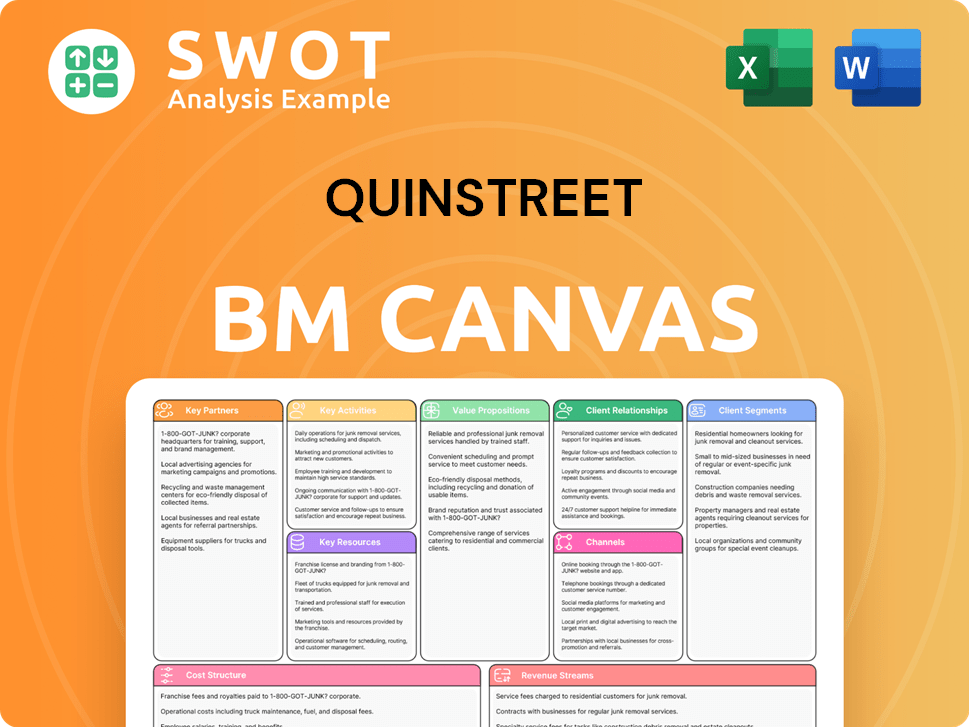
What Recent Changes Have Shaped QuinStreet’s Ownership Landscape?
Over the past few years, the QuinStreet company has demonstrated consistent growth, especially in its core performance marketing sectors. The fiscal third quarter of 2025 saw a substantial increase in revenue, reaching $270 million, a remarkable 60% year-over-year increase. This growth was significantly driven by the auto insurance sector, which surged by 165% year-over-year, and the home services sector, which grew by 21% year-over-year during the same period. For the fiscal year 2024, the company reported revenue of $613.5 million, reflecting a 6% year-over-year increase, demonstrating sustained financial performance.
In terms of ownership, the QuinStreet ownership structure remains largely dominated by institutional investors. As of May 2025, these investors held approximately 92.76% of the company's stock, with a slight increase of 0.5334%. Conversely, insider holdings decreased from 3.85% to 3.73% in May 2025. The company's focus on its current public structure is evident, with no major announcements regarding potential privatization or significant shifts in its operational framework.
The company is proactively adapting to potential regulatory changes, particularly regarding the Telephone Consumer Protection Act (TCPA). Anticipated adjustments by the Federal Communications Commission (FCC) are expected to positively influence the company's business model in the long term. This strategic preparation underscores Who owns QuinStreet's commitment to navigating regulatory landscapes and ensuring sustained operational success. This proactive approach indicates a forward-thinking strategy to maintain and enhance its market position.
| Metric | Value | Year |
|---|---|---|
| Revenue | $270 million | Fiscal Q3 2025 |
| Year-over-year Revenue Growth | 60% | Fiscal Q3 2025 |
| Auto Insurance Revenue Growth | 165% | Fiscal Q3 2025 |
| Home Services Revenue Growth | 21% | Fiscal Q3 2025 |
| Total Revenue | $613.5 million | Fiscal Year 2024 |
| Institutional Ownership | 92.76% | May 2025 |
| Insider Holdings | 3.73% | May 2025 |
Institutional investors hold the majority of QuinStreet stock, indicating a stable ownership base. The company's focus remains on its core business model.
Strong revenue growth in key sectors like auto insurance and home services demonstrates effective market strategies. The company has shown robust financial results.
The company is preparing for potential changes in TCPA regulations, showing a proactive approach. This adaptation is crucial for long-term success.
The company's focus on its core business and proactive regulatory stance suggests a positive outlook. QuinStreet investors should continue to monitor these trends.
QuinStreet Porter's Five Forces Analysis
- Covers All 5 Competitive Forces in Detail
- Structured for Consultants, Students, and Founders
- 100% Editable in Microsoft Word & Excel
- Instant Digital Download – Use Immediately
- Compatible with Mac & PC – Fully Unlocked
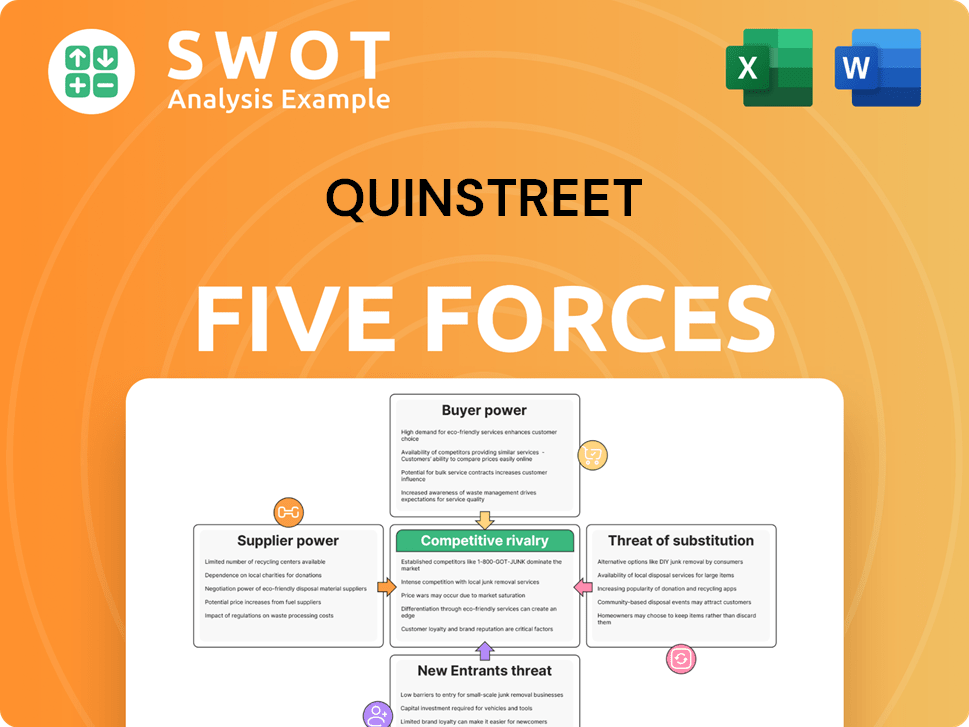
Related Blogs
- What are Mission Vision & Core Values of QuinStreet Company?
- What is Competitive Landscape of QuinStreet Company?
- What is Growth Strategy and Future Prospects of QuinStreet Company?
- How Does QuinStreet Company Work?
- What is Sales and Marketing Strategy of QuinStreet Company?
- What is Brief History of QuinStreet Company?
- What is Customer Demographics and Target Market of QuinStreet Company?
Disclaimer
All information, articles, and product details provided on this website are for general informational and educational purposes only. We do not claim any ownership over, nor do we intend to infringe upon, any trademarks, copyrights, logos, brand names, or other intellectual property mentioned or depicted on this site. Such intellectual property remains the property of its respective owners, and any references here are made solely for identification or informational purposes, without implying any affiliation, endorsement, or partnership.
We make no representations or warranties, express or implied, regarding the accuracy, completeness, or suitability of any content or products presented. Nothing on this website should be construed as legal, tax, investment, financial, medical, or other professional advice. In addition, no part of this site—including articles or product references—constitutes a solicitation, recommendation, endorsement, advertisement, or offer to buy or sell any securities, franchises, or other financial instruments, particularly in jurisdictions where such activity would be unlawful.
All content is of a general nature and may not address the specific circumstances of any individual or entity. It is not a substitute for professional advice or services. Any actions you take based on the information provided here are strictly at your own risk. You accept full responsibility for any decisions or outcomes arising from your use of this website and agree to release us from any liability in connection with your use of, or reliance upon, the content or products found herein.